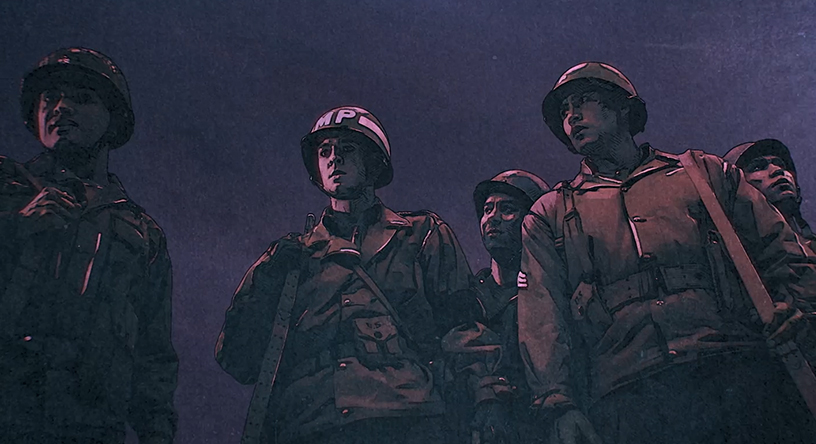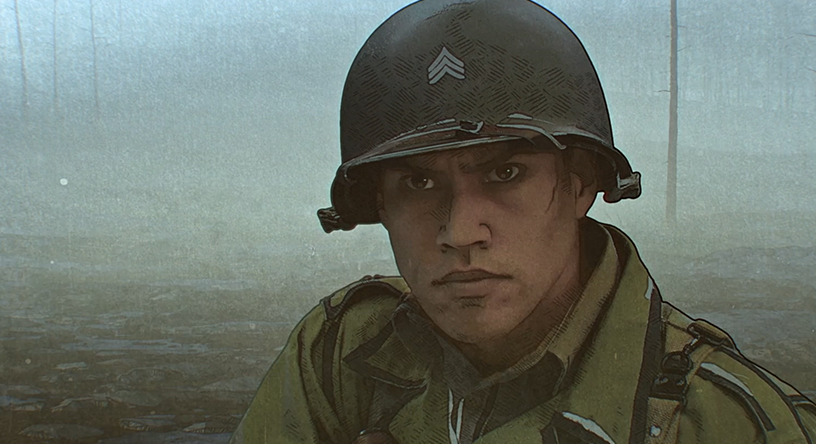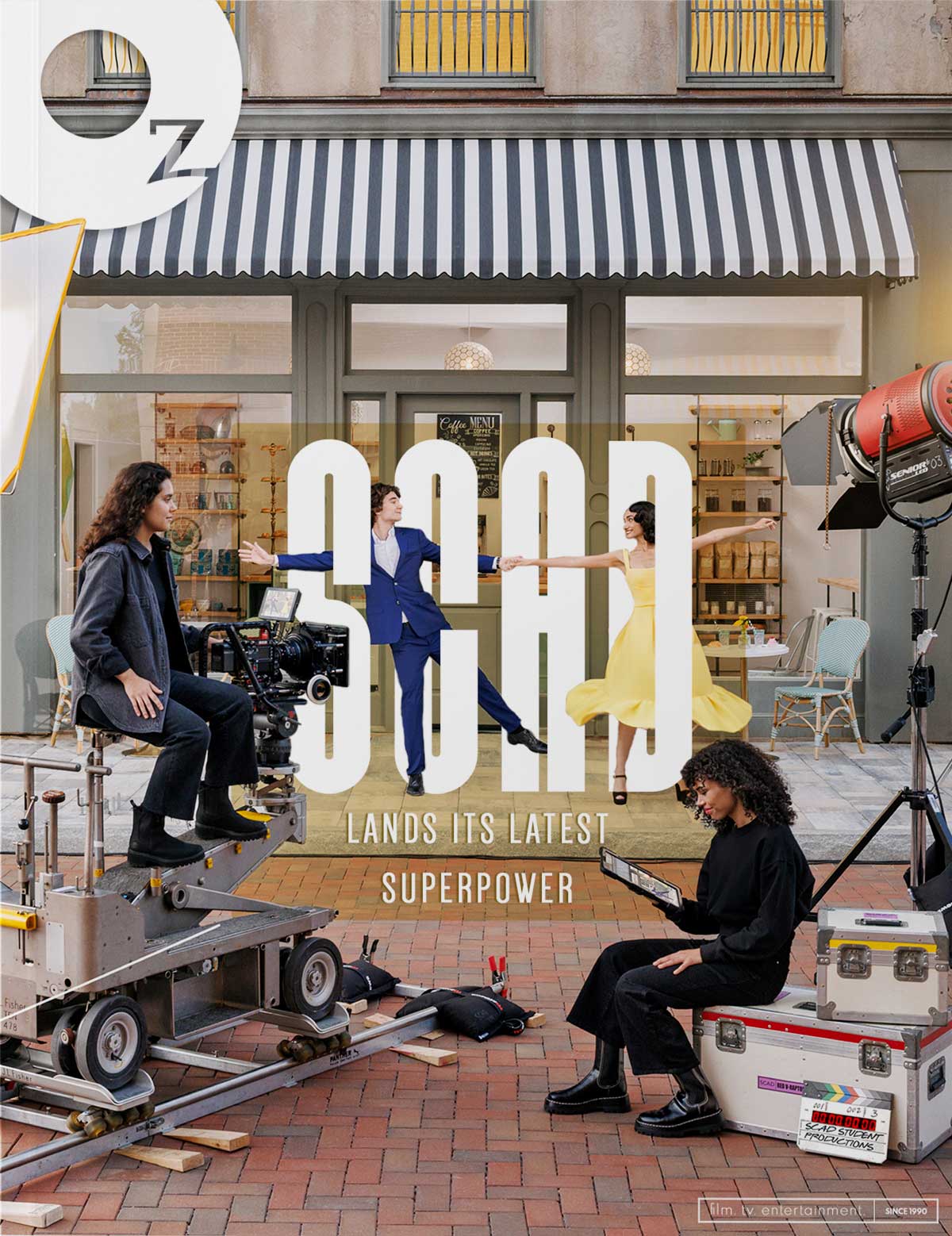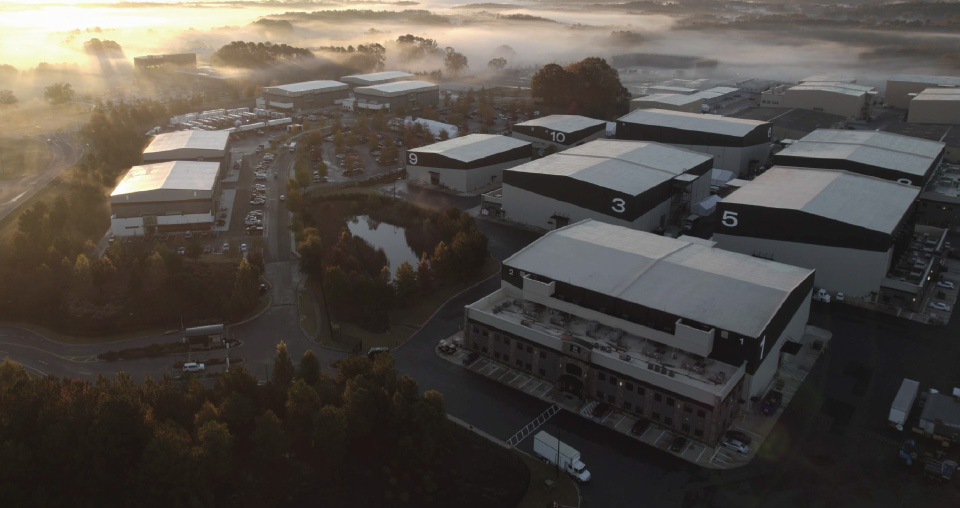

The Georgia film industry has been through many changes over the last few months. During times of resilience, we are uncovering just how talented, strong, and innovative Georgia creators are. Whether the job is a blockbuster film, a television series, or a micro-budget independent production, Georgia’s industry workers are ready to deliver the best possible product; especially now, when it can feel like there’s so little happening, Georgians are making big strides in the industry.
LC Crowley and Brandon Barr, are two Georgians who are making waves with the launch of their groundbreaking animation studio, Trioscope Studios. The Atlanta-based studio is looking to become the Pixar of adult animation. Crowley and Barr are veteran producers and entrepreneurs. As previous co-founders of Atlanta’s School of Humans, they built a reputation on genre defying and experimental projects such as “Daytime Fighting League” (Adult Swim), “Stuff You Should Know” (Science Channel) and “Behind the Screens” (Netflix) as well as progressive approaches to content through their podcasts, including the critical hit Hell and Gone. Three years ago, the duo began working on a new animation software ahead of its time. When seeing the potential for this software (which is also named Trioscope), Crowley, and Barr teamed up with award winning Director, Animator, and VFX Artist, Grzegorz Jonkajtys, to transform Trioscope into its own company. Jonkajtys has served as a VFX Creative at Lucasfilm, Industrial Light & Magic as well as CaféFX. His directorial acclaim includes international short films such as Ark and The 3rd Letter, and among his many credits include Star Wars: Episode VII The Force Awakens, Solo: A Star Wars Story, Avengers: Infinity War, Sin City, Pan’s Labyrinth and The Revenant. This team of high achieving creatives is raising the bar during a time that feels like a stand still.

The new studio is dedicated to next generation enhanced hybrid animation. With Crowley as Chief Executive Officer, Barr as Chief Content Officer, Jonkajtys as Chief Creative Officer, and Brian Lavin, who has served as a Senior Development Executive at Discovery Communications, Red Bull Media House and Viacom, as Senior Vice President of Development, the studio is looking to be the next heavy hitter in our industry. Although new, the studio has already made partnerships with Dark Horse Comics, Oni Press, Unique Features, Conoco (Conan O’Brien’s company), Netflix and Hulu for unannounced projects.
As the studio prepares for these upcoming projects they are a part of a series release that is three years in the making. In November, “The Liberator,” a new animated series created entirely in Georgia is coming to Netflix. From the conception of the studio to the approaching release of “The Liberator,” Trioscope is telling stories in a new medium. “The Liberator” is a war story taking on new technological advances while showing great promise of what Georgia has to offer.
Trioscope Studios, Moonshine Post, and Bare Knuckles Creative, all Atlanta-based companies, have come together with Netflix to bring the series to life. Unlike traditional live-action or animation, “The Liberator” features a style that presents the escapism of animation and the emotion of a live-action drama. Originally, “The Liberator” was announced as a live-action. A&E Studios had acquired the project prior to Netflix’s involvement, but the cost to create the series proved to be too expensive. With a bit of good timing, Trioscope was able to come in after an approach by Netflix and present them with a hybrid animation option for a fraction of the cost, landing them the series.
As a hybrid animation, “The Liberator” stands to deliver entertainment to adult viewers in a way often disregarded by western audiences. While some countries have adopted the use of animation for all ages, the genre oftentimes has been disregarded in the United States as a storytelling medium intended for younger viewers. When presented to American adults, animation usually features raunchy comedies or satires, like “Big Mouth” and “Family Guy”; “The Liberator” is neither of those. The latest Netflix series is written by Jeb Stuart (Die Hard, The Fugitive) and produced by A&E Studios and Unique Features. “The Liberator” is an action packed World War II animated series featuring a group of young men during a 500+ day battle. The narrative is based on historical events and friendships. Following Indigenous people, Mexican Americans, and cowboys who are drafted into the war as they fight side by side during a time of racial injustice. This drama-filled series will highlight the camaraderie of these men as they go overseas to save the world.
While the show will appeal to viewers who enjoyed Saving Private Ryan or Band of Brothers, younger viewers can expect the story to be relatable to current times as the heroes band together and fight in a time of inequality. In addition to the story’s content, the series presents the latest developments in animation, all stemming from Georgia. While war stories are not new to filmmaking, the technology behind the series is. By creating a new way to envision the world, the cutting edge animation also makes “The Liberator” visually relevant to cinephiles who are looking for a modernized war story.
Trioscope is combining live-action and animation in a way that is revolutionizing how content is produced. “[The software developments allow us to] build our stories around the human expressions on the faces of actors while at the same time opening up the epic kind of world-building possibilities that animation allows,” Barr said.
By combining human performance with animated backgrounds, Trioscope is able to produce a first-of-its-kind viewing experience. It has become the only medium to give human faces photo-real quality. Filled with breathtaking cinematic visuals, the medium takes on visual storytelling on a cost-effective budget. For a third of the cost of live-action, Trioscope is able to produce what they’ve described as the moving graphic novel.
The concept behind Trioscope’s coveted technology will remind animators of rotoscoping but the process used is far ahead of the traditional technique. While rotoscoping involves tracing over live-action footage, Trioscope is creating their backgrounds from scratch. Since “The Liberator” actors were shot on a volumetric stage, the studio is tapping into the imaginations of it’s artists while still giving the actors a way to take the limelight on a stage. The result is a visual representation of the talent at hand.

Until you look at the Trioscope process, combining live-action and animation may not sound cost-effective. When beginning to create Trioscope, the team intuitively changed its pipeline. “In the big-budget drama category, scope and scale really are the enemies of the cost,” Crowley told Oz. Trioscope’s process still uses everything live-action requires, such as the crew, creatives, technicians, talent, etc., the live- action portion of production is on a smaller scale than other content of its kind since it is shot entirely on a stage. This cost reducing process is part of what makes Trioscope and it’s pipeline so enticing to large streaming platforms like Netflix. While the studio’s current price tag on their productions is still high, Trioscope plans to make their studio even more appealing by reducing the cost over time with various AI automations and neuro-style transfers, making it appealing to filmmakers of all levels.
This cost effectiveness could alter the way we produce content while making the filmmaking process even more affordable to Independent creators. Although the studio’s new technology is not available to the public, the potential for positive impact on our industry brings great promise to creatives looking to revolutionize storytelling.
Trioscope’s process is not only cost-effective but safer in times of COVID-19. Their production method blends smoothly into the needs of the current state of the world by using a green/blue screen and allowing filmmakers to adapt to any type of environment they are looking for. This socially distant medium requires crews of less than 50 people, reducing the risks of exposure to COVID-19 in comparison with traditional productions. This method along with the constant updating of their systems creates a safe, efficient, and more enticing production environment for the industry. While the pandemic will not last forever, Trioscope’s strategy keeps costs low, making the studio more economically sustainable for years to come. As their technology advances, viewers can expect Trioscope to draw more unique projects and big name companies to Georgia in addition to their current partnerships.
Georgia has always been a desirable location for production; from tax breaks to talent, the reasons to live and work in the Peach State are plentiful and ever growing. However, while Georgia has been the location for major motion pictures, television, and animation for years, when someone thinks of the American film industry, Georgia is not always first to come to mind. Why is that? While audiences are used to seeing the peach at the end of television series or film’s credits, signifying that the production was made in Georgia, the entire process of a show or film’s creation may not remain in the state. On the contrary, “The Liberator” is not only taking advantage of the tax incentives and other assets, it is keeping post in Georgia as well. In turn, the show is building something that expands the state’s job market and places a bigger emphasis on originating content. “We really see the vision of Trioscope to be different in that we want it to have a nice Atlanta stamp on it in all respects,” says Crowley.
“The Liberator” is the next step towards world recognition of Georgia made content. The series brings forth a look only Atlanta can provide and the company’s patents serve as a testament to our local industry’s ability and innovation. When first creating the show, the studio looked back on how they created a final product. Taking up to a year to create the pilot, Trioscope realized they needed to invent so much of the technology to get there. These developments called for the need of a patent. Protecting the intellectual property and furthering the mission for people to understand and start to talk about the technology, the patent clarifies that Trioscope is both a platform and a technological tool.
The decision to patent their discoveries ultimately resulted in the team moving forward to establish Trioscope as its own independent animation studio. Joining the list of reputable animation studios within Atlanta, Trioscope’s unique technology will ultimately raise a generation of artists on the Trioscope pipeline, further diversifying the production of animation in the state. Following a long history of cinema, the technology will serve as a format to unlock visions for talented filmmakers.
“We see a time in the future, in the not so distant future, where all of the major streamers and cablers and distributors alike will see what we see now, which is the power of animated drama,” Crowley said. Recognizing the world-class film and animation communities established here, Trioscope offers the opportunity to be something unique and new that blends those two communities to build new and extraordinary pathways in the Peach State. With this new style of storytelling, a new genre of filmmaking is brought to the industry. The limitations of cost are no longer the barrier to entry and the technology is updating in real time.
“The goal of the storyteller no longer needs to be photo-real if you’re focused instead on really getting across the emotion of the thing.”
-Brandon Barr, Chief Content Officer at Trioscope Studios
Filmmakers can now experience a creation process that uses some of their existing skills alongside a new system to create the projects that may have never been possible due to scope or scale. Now, there’s a sense of liberation between scope, imagination, and cost. The phrase “the possibilities are endless” has never been more true. Filmmakers can create detailed historical sites or vast scenes while maintaining the emotional elements of real humans. Even actors have something to share in this new experience as they rely on their expansive imaginations to perform on stages. While visual excellence is always at the forefront of the film and television industry, the ability to convey genuine emotion is what expands storytelling in this style. “The goal of the storyteller no longer needs to be photo-real if you’re focused instead on really getting across the emotion of the thing,” Barr said.
For filmmakers, the goal of storytelling is often to evoke a reaction from the audience. While VFX and other visual technologies are constantly growing and changing, the ability to see real depth in a performance can make or break a film or show’s success. In some initial testing, Trioscope was able to recognize that after two minutes of viewing, an audience member forgets they are watching anything but live-action. What does this mean for filmmakers? Ultimately, Trioscope will bring the suspension of disbelief to viewers at home – blurring the lines between live-action and animation with their patented process.
While this technology is not yet widespread, Trioscope is rolling out a new plan to offer incoming, Georgia-based filmmakers the experience needed to work with this advancement. For artists first graduating college, the next step in their careers can be an unclear and difficult path to start. Trioscope is easing this process with the opportunity to develop needed skills in their institution. They are currently in the process of creating a trainee program for up and coming artists in VFX and animation. Trioscope plans to train newcomers in understanding exactly what it is they are doing at the studios. The program will be released in partnership with ASIFA-South as a way to give hands on experience while still developing much needed skills. However, this development is nothing new for the Trioscope team. With a history of student training and previous incubators for young artists to develop skills on paid gigs, the company’s founders are reinvesting in Georgia talent to help make this state the obvious choice for production.
Trioscope has developed an intrinsic custom toolset and their pipeline is very different from the traditional workflow. Their training program will help artists in borrowing best practices from all sides of the industry, enhancing the skills they come in with. From a post-production standpoint, Trioscope has also partnered with CMII. The studio is the largest client of the CMII volumetric stage, which speaks to their strong connection to Georgia. Not many workers in the film and television industry, other than these prospective students, will get the experience of working with a volumetric stage. While most people understand the principles of the process, the practice of it is where the art comes into play. As Trioscope moves into post-production, VFX, and animation, the studio acknowledges all the schools and the various great shops that are in the state. Georgia universities have really colitivated a community that makes Trioscope’s progressive programs possible.
From production to post, “The Liberator” is proof that our state has what it takes to produce quality content for a global audience. “The Liberator” is expected to draw audiences in the US and Europe for its Netflix release. Before the creation of Trioscope Studios, both Crowley and Barr have had a decade long history of work during their previous endeavors at School Of Humans with Moonshine Post-Production. The two companies once shared a building, and their adventurous spirits and positive work relationship made it possible to bring yet another technological advancement to the show.
Moonshine was able to look at the show at an early concept stage while Trioscope was still in an initial testing phase. “We’ve pioneered a lot of stuff alongside Trioscope in terms of work flows and posts,” Post Producer and Founder of Moonshine, Drew Sawyer, told Oz.
When approached about the concept, Moonshine and Trioscope took on a can-do attitude to attempt to create the new storytelling style. The companies worked closely for a year prior to any shooting, developing estimates and workflows. Now, almost three years after the conception of Trioscope, the studio has been brought to life. This is the first time the companies have done a full cart, full finish production and the first hybrid animation show done by Moonshine Post.
As one of the leading posts in the South, enlisting Moonshine was an easy decision. Moonshine was already making an investment into the kind of technology and training for personnel so that they could take on a larger style Adobe show.
Moonshine and their sister company, Bare Knuckles Creative, has exercised the use of two new technologies, Adobe Atlas and Adobe Vision. While much of their work flow remains the same, the process is intensified by the use of the new software. With “The Liberator,” the whole show can be considered a media effects shot with broader color range and enhanced sound.
The Adobe technology used on “The Liberator” is the shiny object for Moonshine’s creatives. This type of technology reinvigorates the art form for the colorists. It is an exciting new frontier for them to explore in terms of the color gambit and what they can do with it. The same can be said for the sound team. When working with Adobe Atlas, it comes down to the mixer. While fabricating entire war scenes from scratch is nothing new for animation, the Trioscope pipeline requires sound design shops to fill out the environment. In this process, Moonshine and Bare Knuckles were able to use their sound shops and dive into a fun creative part of sound design. With the team’s excitement and the new Adobe advancements, the mixers are now expanding what the audience is able to hear. Throughout the process, Adobe has given way to more creative collaboration. Currently, Moonshine is the only shop in Georgia that is using Adobe Vision and Adobe Atlas for long form, television series, and feature works.
In the completion of “The Liberator,” as Trioscope took the initial dive into the workload, Moonshine was able to bring the collaboration to the screen. “It’s really just our job to make sure that every bit of that hard work makes it on the screen and then if we can add to it, collaborate with them, then that’s our job … Moonshine is working at the level that everyone has been aspiring to work at,” Sawyer said.
What does this mean for Georgia? It proves there is a trend forming. People are opening up to the idea of keeping post in the state. “We’re doing long form television in the state of Georgia, when that wasn’t even a glimmer in the eye, or a thought or an opportunity several years ago,” Sawyer explained.
Moonshine and Trioscope are both confident that as “The Liberator” shows success, it will bring another show to Georgia, and another, and so forth, creating an influx of opportunities in the market.
The Georgia film and animation communities have definitely produced the cream of the crop of storytellers. By constantly having to prove themselves on features and series, Georgia storytellers are prepared to do a big show such as “The Liberator,” and more to come.
“It’s not Moonshine’s job to do them all, but it is our job to make sure we do them as good as possible, if not better, every time so that more people will come and shoot the same,” Sawyer said when asked about the potential for more post work in Georgia after the release of “The Liberator.”
“The Liberator” is proof that Georgia’s film industry will thrive and expand despite the current state of the world. The technology, while alluring for new business, is a step towards the expansion Georgia needs and the innovation the film, television and animation communities are looking for. As the industry looks to get back to work, filmmakers can look forward to this new mode of storytelling as a sign of the exciting possibilities within Georgia’s creative community.






